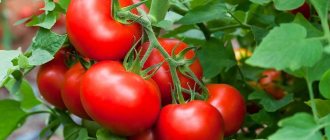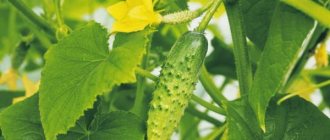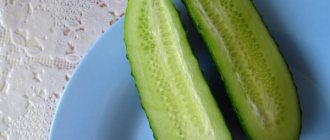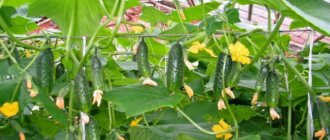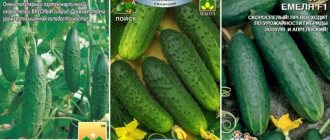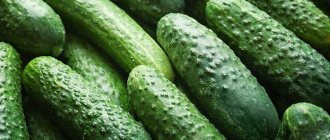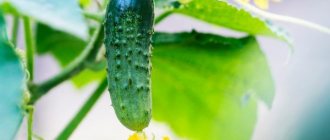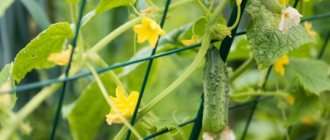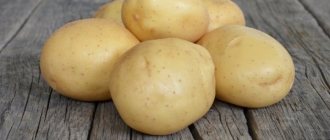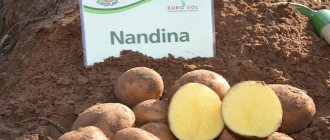Cucumber Maryina Roshcha F1: variety description
This cucumber hybrid is a parthenocarpic - a plant that does not require pollination by bees
and other pollinating insects, its fruits are formed without pollination, and the seeds inside the greens remain even when the fruits are fully ripened at the stage of milk maturity. Therefore, seed material from such vegetable crops cannot be collected; they must be purchased annually from gardening stores.
Since this variety does not require pollination, the Maryina Roshcha cucumber can be grown almost anywhere - in the garden, greenhouse, film greenhouse, glassed-in balcony or even on the windowsill in the apartment.
Since the vines of this hybrid are long (about 2 m), when grown indoors, it is recommended to tie them to trellises, and in garden beds to stretch a special mesh with fairly large cells, to which the cucumber lashes are attached using tendrils.
On a note!
The Maryina Roshcha cucumber is distinguished by its early ripening - from the moment the first shoots appear until the ripe greens are harvested, just over a month passes.
The scourges are quite powerful and well leafy. The plant actively develops lateral shoots, on which bunches of gherkins are formed after fruiting on the central stem ends. As a result, harvesting from Maryina Roshcha cucumber bushes continues throughout the entire season until the onset of cold weather.
.
The foliage is medium in size, five-lobed, with wavy edges, light emerald in color.
Cucumber Maryina Roshcha. Brief overview, description of characteristics - video
Hybrid Maryina Roshcha - bunch type,
its ovaries are formed in short internodes in bunches, in each of which up to 8 pieces can appear. At the same time, up to 10-12 gherkins ripen on a cucumber vine. Moreover, the fruiting of this hybrid is stable and does not stop even under unfavorable weather conditions, which is another advantage of the Maryina Roshcha cucumber.
Ripening greens are gherkin-type, smooth, approximately the same size. Cucumbers grow up to 10-12 cm in length, and the average weight of fruits of the Maryina Roshcha variety is about 85-100 g
. The skin is compacted, crispy, covered with small tubercles with short soft light spines. The color of gherkins is rich emerald, with short light stripes.
The pulp is tender, juicy, dense, white in color with a green tint, without bitterness, no voids are formed inside.
It is necessary to collect gherkins as they ripen so that new ovaries begin to form.
Ripe greens can be transported to any distance, the shelf life of the crop is high, and if stored properly, greens can last up to 3 months without losing their positive qualities and taste.
Good varieties of cucumbers:
Cucumber True Friends F1 Cucumber variety Marinda F1 Cucumber “Sanka’s Love” F1
Productivity
The yield of the Maryina Roshcha hybrid is high; from 1 m2 you can harvest up to 10-12 kg with proper care of these cucumber bushes.
After pinching the top of the central shoot at a height of about 2 m, lateral shoots begin to actively form on the plant, on which new fruits are formed. With the timely collection of ripe greens, new bunches of ovaries begin to form, as a result, the bushes of the Maryina Roshcha variety bear fruit in waves.
Review of Maryina Roshcha cucumbers - video
Reviews
Gardeners leave various reviews about the cucumber hybrid Maryina Roshcha, mostly positive.
Valentina, Tula: “I planted three-week-old Maryina Roshcha seedlings in a greenhouse. I was afraid to go straight into the ground because spring was cold. It turned out that she did the right thing. At the beginning of June we already tried the first cucumbers. Delicious, crispy, the whole family liked it. The greenhouse yielded a bountiful harvest. Watering with warm water and fertilizing once a month with mineral fertilizers gave good results.
Anna, Kemerovo: “A neighbor advised me to plant Maryina Grove. I decided to try it and was not disappointed. I planted it in May, when the weather was warm, straight into the ground. After a month and a half, we were eating cucumbers with all our might. I didn’t fertilize it with anything additional. Despite this, the plants did not get sick and gave a good harvest. I liked the taste of the cucumbers, although the skin seemed a little tough.
Application area
Ripe gherkins have a good taste, crispy and tender, they are great for preparing vegetable salads, and are good as appetizers. Also, these greens at the stage of pickles and gherkins are used for salting and pickling.
The fruits tolerate heat treatment well, they do not spread, no voids form inside, the cucumbers remain crunchy, dense and juicy, and bitterness in the greens of Maryina Roshcha is absent at the genetic level.
Harvesting and application
Harvesting begins a month and a half after sowing and continues until late autumn. Almost from the beginning of June until October, you can enjoy fresh cucumbers every two or three days. They should be collected as they ripen in the evening, avoiding overgrowth. Neat, smooth fruits are good for pickling and pickling.
Excellent keeping quality and transportability allow summer residents to make money from cucumbers. Beautiful fruits that can be easily transported over long distances are always in demand among buyers.
Diseases and pests
In general, all hybrid cucumbers are highly immune to most diseases.
Pest in the garden!
Aphids on cucumbers
And the Maryina Roshcha cucumber is no exception; it is practically not susceptible to the following diseases:
- powdery mildew;
- olive spot;
- cucumber mosaic;
- downy mildew;
- all types of rot.
To ensure that this vegetable plant does not suffer from other diseases and is not damaged by pests, it is recommended to follow the rules of cultivation and further care, as well as crop rotation, and carry out preventive treatments of cucumber vines.
Fetal characteristics
Tomato Maryina Roshcha
The vegetable is oblong, cylindrical in shape. The surface is uneven, lumpy, with a moderate number of white spines. The color of the fruit is bright green, yellow stripes are visible at the tip, not reaching the middle. The weight of one cucumber is 110 g. They reach 10-12 centimeters in length. The flesh is crispy and dense. In cooking it is used fresh and pickled. The taste is sweet-cucumber, pronounced cucumber aroma. There is no bitterness. Perfectly suitable for all types of workpieces.
The variety has good resistance to cucumber mosaic virus, olive spot, and is tolerant to downy and common powdery mildew.
Advantages of Maryina Roshcha cucumber
Of the main advantages of this vegetable crop, it should be noted:
- good yield;
- precocity;
- fruiting is extended over time;
- fruits are formed on shoots without pollination, so Maryina Roshcha cucumbers bear fruit well in greenhouses, at home, on balconies, loggias;
- this hybrid does not reduce fruiting during sudden changes in weather conditions;
- the versatility of collected gherkins;
- good resistance to many diseases;
- the harvested crop can be stored in appropriate conditions for more than 2.5 months.
The Maryina Roshcha hybrid has no serious drawbacks, but it should be noted that the vines of this cucumber require a mandatory garter, and seed material must be purchased at specialized retail outlets annually.
Planting cucumbers Maryina Roshcha F1
This cucumber hybrid can be grown in seedlings and without seedlings.
. At the same time, there are usually no special difficulties when growing these cucumbers; the main thing is to plant the seed correctly and provide proper care to the growing cucumber bushes in the future.
Photos of cucumber seeds Maryina Roshcha F1
Planting without seedlings
Maryina Roshcha cucumber seeds can be planted directly in open ground in the garden or in a greenhouse only when the soil warms up to 15-16 degrees Celsius.
In greenhouse conditions, Maryina Roshcha seed material is planted in late April - early May. First, you need to remove the top layer of soil in the greenhouse and add a new nutrient substrate, while simultaneously disinfecting all greenhouse structures to prevent the development of diseases.
Photo of a seedless method of planting cucumbers
On a note!
Maryina Roshcha cucumber seeds should be planted in open ground garden beds around the middle or end of May, depending on the climatic conditions of the growing region.
Seeds are planted in rows at a distance of 0.4 m from each other. The distance between cucumber rows should be at least 0.6 m. The germination rate of seeds of this variety is close to 100%.
Growing cucumber seedlings Maryina Roshcha
Seed material for seedlings is planted in separate containers approximately 20-25 days before the planned transplantation of seedlings to a permanent location.
Cucumbers do not tolerate transplantation well, as their roots are too tender, which are injured during transplantation and picking. Therefore, Maryina Roshcha cucumber seeds are planted one at a time in separate cups or peat tablets.
Cucumber seedlings. A simple way to grow - video
In the process of growing seedlings, you should place the plants in a well-lit, warm place and water as the soil dries.
Advice!
10 days before transplanting the seedlings to a permanent place, the seedlings begin to harden, lowering the temperature in the room by 5-7 degrees. You can also take cucumber seedlings out onto the balcony for 30 minutes, increasing the time the plants stay outside every day.
Adult cucumber seedlings are transplanted to a permanent place by transshipment along with a lump of earth. With such a transplant, the roots are not injured, and the seedlings quickly acclimatize to the new location.
Features of agricultural technology of the variety
May be interesting Colette potatoes: description and characteristics, reviews Potato variety "Colomba" - early and productive Cherry "Iput" description of the variety
Maryina Grove can be planted in two ways: seedlings and directly with seeds in the ground. It is recommended to plant in loamy or sandy loam soil. This is necessary so that the soil allows water and air to pass through well. Heavy soil needs to be fertilized with peat.
When planting by seedlings, you need to plant the seeds in peat pots with garden soil, and then plant the seedlings directly into the soil. With this method, the root system of the sprouts is not damaged. Deepen the seeds into the holes no more than 1.5 cm. Before the sprouts germinate, the temperature in the room should be about 24 degrees. When the main part has already sprouted, the temperature must be reduced to 15-16 degrees. From the moment the seeds germinate until the first cucumber ripens, it takes about 40-45 days. Sowing begins in April-May, but the harvest can be harvested from July to August.
It is recommended to start planting directly into the ground no earlier than mid-May to ensure that the threat of frost is avoided.
Note!
The plant can withstand temperatures only up to 0 degrees. A drop in temperature below this mark can destroy it.
Planting density when grown in a greenhouse is 2.5 plants per m2, in open ground 3-4.
Complex of care procedures:
- Mandatory evening watering, every three days.
- Weeding.
- Fertilizing with mineral and organic fertilizers, it is advisable to alternate them. 4 stages: 3 weeks after planting, at the moment the first gherkins appear, the next 2 feedings should be carried out every 2 weeks after the previous one.
- Loosening the soil must be done very carefully so as not to accidentally damage the stem. By loosening, the crust on the soil is removed, which interferes with the passage of oxygen to the root system of the plant.
Tying the lashes to the support is a must. For these purposes, you need to stick a vertical stake into the ground next to the bush. Tie a thin horizontal plank on top of it. If the height of the support is less than one and a half meters, then simply throw the whips over it. If the support is higher than one and a half meters, then you need to tie the shoots with twine. For convenience, it is recommended to form the bush into one stem. In addition, the plant will grow more actively and bear more fruit.
From the main shoot, remove all vegetation in the axils of the first 5-6 leaves. Leave only 20 centimeter shoots above. Leave 30-40 cm shoots in the next 5-6 leaf axils. Further, similarly 40-45 cm. The top needs to be pinched.
When insects appear on the bushes, treat with special preparations, for example, Regent or Tabu, according to the instructions attached to them. Harvesting every 2-3 days. Regular harvesting of fruits increases the yield of the bush.
Store harvested vegetables in the refrigerator or in a cool, dark place. The average period is 2.5-3 months.
Further care for the Maryina Roshcha cucumber
In the future, you should water adult plants in a timely manner, promptly apply fertilizers for Maryina Roshcha cucumbers, tie the vines to trellises or other supports, and also promptly remove weeds.
Irrigation regime
Water cucumbers of the Maryina Roshcha variety in the morning or evening hours strictly at the root, trying to prevent moisture from getting on the foliage and stems. Water for irrigation should be warm and settled.
During the watering process, the soil should be constantly moistened, but there should be no stagnation of moisture in the soil.
Feeding cucumber plants
The Maryina Roshcha cucumber responds well to the application of organic and mineral fertilizers to the soil.
Many vegetable growers use a solution of mullein or bird droppings as a fertilizer for cucumbers.
During the period of formation of ovaries and ripening of gherkins, it is recommended to apply superphosphate and potassium salt to the plants, which promote the ripening of gherkins and improve their taste.
Basic rules of care
Growing the Maryina Roshcha hybrid does not differ from the rules for caring for other similar crops. To get a harvest you need to follow the standard rules.
- Watering. Cucumbers are a moisture-loving crop, so water the plants regularly. The water should be at room temperature; it is best to use settled rainwater.
- Loosening. A mandatory procedure that helps cope with harmful microorganisms. Loose soil allows oxygen and water to pass through faster. Do not immerse the teeth of the tool to a great depth, since the roots of cucumbers are superficial and may be damaged.
- Weeding. The presence of weeds in the garden bed quickly leads to damage to cucumber plantings by diseases and infections, as well as soil oxidation. In the absence of weeds, micronutrients reach the plant faster.
- Feeding. Fertilizers are applied every two weeks. Various organic and mineral compounds are used.
It is important to harvest the crops on time. If you leave ripe cucumbers on the vines, the formation of new ovaries is stopped.
Cucumber Maryina Roshcha: reviews from those who planted
Olga, 55 years old, Moscow region: In recent years, in my garden I have been growing only gherkin cucumber hybrids, as they are unpretentious, practically do not get sick, and you can harvest high yields of delicious crispy gherkins from the plants, which are distinguished by their versatility of use. The Maryina Roshcha hybrid, which I have been growing on my plot for the fourth season, has all of the above qualities. I use ripe greens for food, and also pickle them in large quantities for the winter, since my family really likes such twists. The variety is characterized by high yield, I recommend growing it to everyone.
Svetlana, 45 years old, Volgograd region: I grow the Maryina Roshcha hybrid in open ground. As the vines grow, I regularly water and feed the plants, and harvest as they ripen. I sell part of the harvest; I store the later harvest in the refrigerator, where the cucumbers can remain for up to 2 months. I also salt and marinate the collected fruits, it turns out very tasty.
Elena, 50 years old, Kemerovo: The cucumber variety Maryina Roshcha was recommended to me by a salesperson at a gardening store. I grew the hybrid Maryina Roshcha in a greenhouse, tall plants - I tied them to trellises, watered and fed them. As a result, I collected about 10-12 kg of gherkins from each square. The fruits were crispy, without voids inside or bitterness, but? In my opinion, the skin of the Maryina Roshcha variety is slightly harsh. Of the preparations, my family likes pickles of this variety the most.
The early-ripening bunched parthenocarpic gherkin cucumber hybrid Maryina Roshcha can be grown almost throughout Russia in garden beds in open ground or in greenhouse conditions.
Due to the high yield and good taste of ripe gherkins, this cucumber variety can be cultivated not only for your own needs, but also for sale.
general description
Marina Roshcha f1 belongs to the parthenocarpic gherkin early-ripening hybrids. The harvest can be harvested 40-45 days after emergence. The peculiarity of the variety is that the plant pollinates itself. The plant is high-yielding. Temperature changes and bad weather have virtually no effect on productivity.
The hybrid was bred by Russian breeders. To enhance the positive characteristics, 2 varieties were crossed. Designed for cultivation in any climatic conditions of the country. Depending on the weather conditions of the area, the planting method differs (open ground or greenhouses).
On a note!
Parthenocarpic varieties are distinguished by the fact that they produce exclusively female flowers.
Climatic conditions do not affect crop productivity. You can harvest until frost. If you follow the growing rules, the productivity of 1 bush is up to 12 kg. They are often grown for trade and on a production scale, since vegetables perfectly retain their presentation and taste during transportation.
The variety is resistant to most cucumber diseases.
Description of the bushes
Maryina Roshcha is a plant represented by long vines. They reach up to 1.8-2.5 m. They require tying and proper formation of bushes. Maryina Roshcha is a first generation hybrid. The bushes have an indeterminate type of development.
Each bush is distinguished by an abundance of foliage and moderate branching. Vertical supports are used to grow crops. Form the plant into 1 stem, removing the side shoots.
